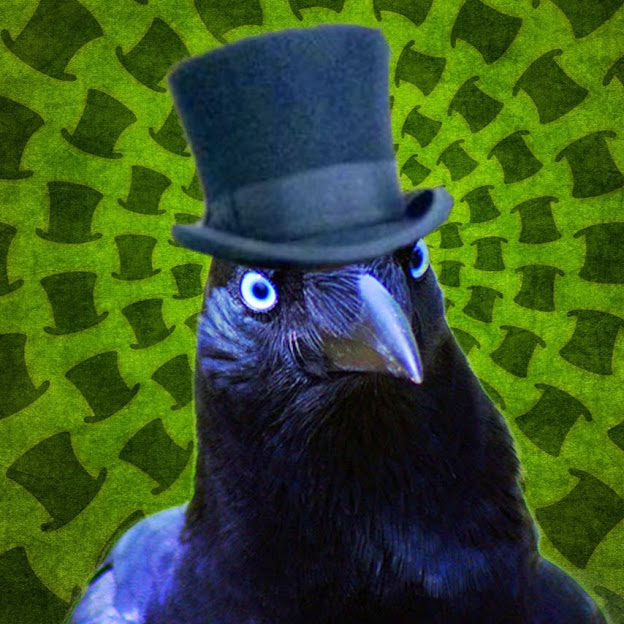Feature image: The Mad Crow by Roy Peak
Poe… try. I mean it. Try Poe… Make Poe’s poe-try day today!
Edgar Allan Poe (1809 – 1849) is best known for his tales of mystery and the macabre. Being part of the Romantic Movement, Poe was one of the pioneers of the short story genre in America and he is considered to be the inventor of the detective fiction genre. He is further credited with contributing to the emerging genre of science fiction. He was the first well-known American author to try to make a living through writing alone, which resulted in a financially difficult life and career.
The historical Edgar Allan Poe has also appeared as a fictionalized character, often representing the “mad genius” or “tormented artist”. Many of these depictions also blend in with characters from his stories, giving the idea that Poe and his characters might share identities.
Edgar Allan Poe is also known for his poem “The Raven.”
“The Raven” (1845) is a narrative poem about a talking raven’s mysterious visit to a broken-hearted lover. The raven is then witness to the man’s slow fall into insanity. The lover, thought to be a student, is lamenting the loss of his love, Lenore. Sitting on a bust of Pallas, the raven gradually increases the student’s distress with its constant repetition of the word “nevermore.”
He talks to the raven and the only answer he gets over and over is “nevermore,” since the bird only seems to know that word. This could be interpreted as the typical replies people who are suffering receive from those they talk to—empty, meaningless words, because the listeners only know those words, those automatic sentences we utter when someone is in distress and we’re out of ideas on how to help or what to say.
“That one word, as if his soul in that one word he did outpour,” the poem says about that constant “nevermore.” “’Doubtless,’ said I, ‘what it utters is its only stock and store,” it continues, as the student realizes the bird must have learned that word from someone else. In the same way a raven would, people often repeat things just because they’ve heard them so many times before. Sometimes “I’m sorry for your loss,” doesn’t necessarily mean they actually think or feel that when they say it, and the person in pain will notice the “nevermore raven” in there.
And still, the student stays curious about the possible meaning of this constant “nevermore,” until he ends up thinking the raven is a prophet. He starts taking its replies as the truth and thus gets mad at the raven when its “nevermore” reply doesn’t meet his expectations. This might be showing the fragility of the spirit of those in great pain—easily broken in despair by the random word of a talking bird.
In his 1846 follow-up essay, “The Philosophy of Composition,” Poe claims to have written the poem very logically and methodically so that it would appeal to both critical and popular tastes of that period.
Poe’s bonus: a few interesting quotes:
I became insane, with long intervals of horrible sanity.
Poe’s Letter to George W. Eveleth (1848).
We often think of sanity as something desirable and madness as something bad, but this isn’t always right. Sometimes ‘insanity’ can simply mean having a moment of inner freedom in a world that expects us to always adjust to ‘the norm,’ or to be ‘normal.’ Perhaps Poe referred to these “long intervals of horrible sanity” as him feeling trapped and restricted within the limitations of the world of the ‘normal.’
All that we see or seem. Is but a dream within a dream.
“A Dream Within a Dream” (1849)
Are we real? Is reality what we see or is it all a dream? Any thinker will eventually come to this question and get lost in it since it’s not that easy to define reality—and the deeper we get into the subject, the more surreal it gets.
They who dream by day are cognizant of many things which escape those who dream only by night.
“Eleonora” (1841)
In other words, those who don’t daydream are seriously missing out. Daydreaming gives us vision, it boosts our creativity, increases our understanding of life the world around us, and even ourselves. Dreaming while we’re sleeping is something that happens to all us, while the daydreamer builds his/her own reality consciously and on purpose.
The boundaries which divide Life from Death are at best shadowy and vague. Who shall say where the one ends, and where the other begins?
“The Premature Burial” (1844)
Sometimes the definition of death is arbitrarily decided: for example, certain signs in the body—no heartbeat, no brain activity, etc—but… what if we were wrong? Could someone still be alive after all those functions cease? After all, what is death? Does it even exist? Could the opposite be possible too? Some people actually being dead and continuing to look completely alive?
Try Poe’s poetry… you never know what you will find!




